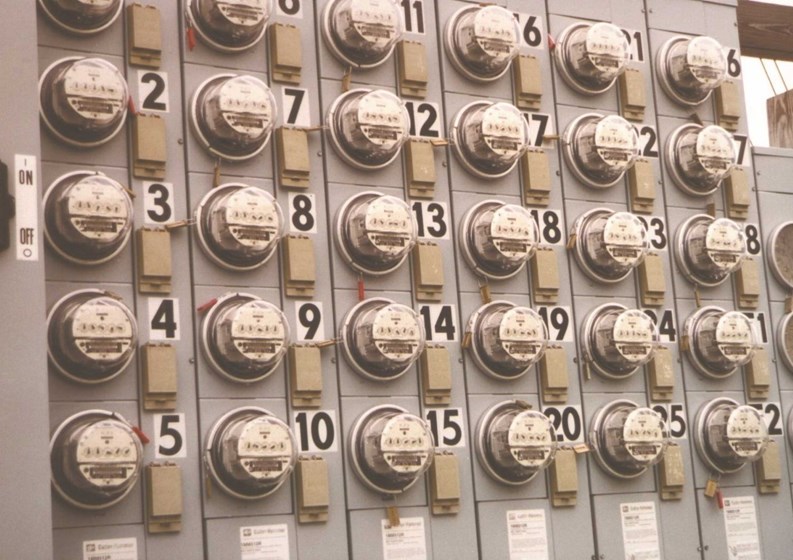Some multifamily buildings have direct metering—the utility owns each apartment’s meter, and each resident pays directly to the utility based on an individual utility rate. Others don’t have electric metering of individual units—the entire building is charged as a whole. This is known as master metering.
Most master-metered buildings were built in the 1950s and ‘60s, when electrical costs were low. The building management charges the individual units either based on the apartment’s size or the number of shares the unit owners have in the co-op.
But let’s say there are two one-bedroom apartments next to each other, one owned by an elderly woman who rarely even turns on her TV set, the other by a young couple with two computers, two window air conditioners, a heavily-used TV, a DVD, a cell-phone charger and more. Is it fair that both would be charged the same amount for electric usage?
And from management’s point of view, master metering can lead to problems when electric costs go up, or when enough of the unit owners or shareholders start to buy super-powerful air conditioners or heaters.
In response to all these problems, more and more buildings with master metering are beginning to switch their electricity usage to submetering, which allows management to bill each unit individually while getting one bill of its own.
Of course, in every situation, people tend to pay more or less based on seasonal factors—for example, many, if not most, apartment residents pay a larger bill in the summer when they’re running their individual air-conditioning units. But with submetering, users will see more of a difference in their electric bills based on usage.
Herbert Hirschfeld, P.E., an energy consultant in Glen Cove, says, “If you’re a unit owner not paying for electricity, there’s no incentives for you to purchase energy-efficient air conditioners or refrigerators or use lower-wattage light bulbs, and no reason not to run your air conditioner continuously from Memorial Day to Labor Day.”
The Public Service Commission (PSC) allows a master-metered building to convert to submetering by installing meters (or submeters) to measure electricity in the individual apartments, according to Hirschfeld’s website, www.submeteronline.com.
The utility company still charges the building at a bulk rate based on the master meter, but the building itself bills each apartment in proportion to its actual usage.
The PSC also allows a directly metered building to convert to submetering by installing a master meter and changing the individual meters to submeters, says the site. This helps such buildings obtain the utility’s bulk rate.
And it may be of particular interest to some readers that the PSC allows conversion to submetering not only in co-op and condo buildings with total unit ownership, but also in those with a mix of owners and tenants (typically buildings that were converted from rentals).
Greg Carlson, executive director of the Federation of New York Housing Cooperatives & Condominiums (FNYHC), says his organization has been advocating the use of submetering in master-metered buildings since the mid-1970s. “It has long been established that by submetering, a building’s electrical usage is reduced by 15 to 25 percent. By going to submetering, it is not only green, it is fair to the residents who will pay for the amount of their usage.”
And that’s not all, Carlson says. With a “smart meter,” he says, a resident can tie his meter to a computer program that will let him know when he is using electricity and how much it can cost him.”
Lewis Kwit, president of Energy Investment Systems, further explains, “You can save by using electricity when capacity is abundant, and refrain when capacity is strained and prices are higher. For example, it’s better to turn on your dishwasher before you go to bed and not during the day. Maybe it’s better to not answer e-mails until nine or 10 o’clock, rather than answer them in the middle of a heat wave at four in the afternoon.”
Some Nuts And Bolts
The way the submeters are installed depends on the design of the apartment building. For example, says Jerry Fund, president of Automatic Meter Reading Corporation, in some older buildings you have electric distribution closets in the basements from which wiring runs directly into the apartments. There, technicians have to go into each apartment and attach the meter there.
“But in most buildings,’ he says, “you have a distribution panel every third floor with a circuit breaker, and the wiring goes from that distribution box down the hall to each apartment. In that case, we can put the meter in that electric closet very simply, hardly even turning off the power.”
Time-Sensitive Pricing
Many people describe one type of billing method that results from submetering as real-time pricing, or real-time billing. “In real-time pricing,” says Carlson, “residents can take advantage and reduce their electrical costs.
Others prefer to use different terms—for example, Hirschfeld prefers the terms time-sensitive pricing or time of use pricing In this type of billing, the apartment itself is billed differently during peak (most expensive), “shoulder,” and non-peak hours.
As an example of submetering with time-of-use pricing, his website gives the example of Georgetown Mews, a co-op complex in Queens containing 37 two-story buildings. The complex installed its submetering system in 2007, implemented shadow billing (straight per-kWh billing, but telling the shareholders what they would pay under time of use pricing to get them used to the idea) in 2008, and then, in late 2008, initiated time-of-use pricing with a three-tier scale: peak usage (most expensive), shoulder and off-peak.
As a result, says Hirschfeld, the buildings’ electric usage during the 12 billing periods up to July 2010 was reduced by 20.89 percent of the adjusted electrical usage and an associated cost avoidance of 20.95 percent. Analysis also determined an adjusted reduction in belling demand of 20.16 percent.
Physical Concerns
Some buildings are easier to convert to submetering than others due to physical reasons. In some buildings that haven’t had new electrical wiring since the World War II era, often have aluminum rather than copper writing and can’t handle heavy loads, says Fund, “installing submetering is virtually impossible without rewiring the building.”
Still, say professionals, if there’s a will, there’s a way.
Hirschfeld says, “I’ve looked at hundreds, if not thousands, of buildings since 1980, and there was only one building complex I can remember where submetering was impossible because of the unusual manner in which it was wired.
“Generally speaking, in 99 percent of all master-metered buildings, it can be done,” he says.
More Examples
If you’re looking for examples of multifamily buildings where submetering has been installed and is working, there are quite a few others. Just some of these are Jefferson Towers, Waterside Plaza, Penn South, Columbus Park Towers, Gotham and West Village Houses in Manhattan; Fresh Meadows, Greenpark Essex and Greenpark Sussex in Queens; Trump Village (Sections One and Two) and Cadman Plaza North in Brooklyn; and Noble Mansion in the Bronx. These examples were given by Hirschfeld and Kwit; there are many more.
How long does it take most residents of submetered buildings to see the financial benefits of submetering? Much of that is up to the unit owners and what action they will be willing to take to reduce energy use. If a unit owner has been overcharged for electricity on a regular basis, then they will begin to see the difference immediately.
Rule of Thumb, and Incentives
By how much does submetering usually reduce owners’ monthly electric costs? Kwit answers that the rule of thumb is 15 to 20 percent, and it can be substantially higher.
For the board and management, there are government incentives for the process. For example, the New York State Energy Research and Development Authority (NYSERDA) earlier this year released its Energy Reduction in Master Metered Buildings (ERMM) Program. The program is available for master-metered multifamily buildings with more than five units where tenants currently don’t pay for their electric usage. The ERMM program provides up to 50 percent of the cost of installing submeters as well as incentives for related energy-efficient appliances. Still, there are very stringent eligibility requirements that may limit a particular master-metered building from participation in the ERMM program.
According to Ryan Moore, NYSERDA project manager, the ERMM program is available for any building or board that wants to lower its energy costs by installing advanced submetering, or Energy Star efficient appliances and lighting. The program he said applies to all market rate co-op and condo buildings and provides up to 50 percent of the cost of installing advanced submeters. Buildings can receive $250 per meter, and $1,500 per master meter. Installing Energy Star appliances, like a refrigerator, is worth $18 each in incentives, with various air conditioning units, a $16-$19 payback, and lighting fixtures, $15 each. An Energy Star commercial clothes washer is eligible for a $365 incentive.
Shareholders in a master-metered co-op must approve entrance into the program by a majority or 51 percent vote, Moore explained.
“It can greatly help reduce your energy costs,” says Moore. “We normally see 15 to 18 percent in actual energy reduction.”
The program is due to expire December 31, 2011, but is likely to be extended. You can find out about the program on http://www.getenergysmart.org/MultiFamilyHomes/ExistingBuilding/BuildingOwner/E RMM.aspx
A Few Common Questions
Here are some answers to common questions, by the way: Submetering does count as a capital improvement, and under submetering, individual apartment owners can’t choose their own power suppliers. Remember, one power supply still comes into the entire building.
While management itself can change the electricity provider for a building, this has nothing to do with submetering one way or the other. The utility or ESCO [energy service company] has nothing to do with the submetering process.
Now that we know about submetering electricity, can other utilities, such as gas, also be submetered?
If you look at the web, it’s clear that in some places, submetering for water, and water costs, is a reality. A company called American Water and Energy Savers advertises it for various types of buildings, including multi-family residential, although the “success stories” they give are from the South and Southwest, not from our area.
“In the New York marketplace,” says Hirschfeld, “if people refer to submetering, 99 percent of the time it’s electricity. In New York high-rises in particular, it’s impossible to submeter water.” Still, one Brooklyn company, Jack Schwartz Water Management, advertises water submetering. Kwit predicts that submetering of water will grow in the future.
Selling the Idea to Residents
So now you know some of the nuts and bolts of submetering. However, there’s another factor, especially in condos and co-ops: the human factor.
“Doing the project is the easy part,” says Carlson of FNYHC. “Selling it to the residents is the much harder part. You have to analyze the demographics of the residents in the building. Do you have rent-regulated residents [like many co-ops that converted from rentals and still have rental tenants]? If so, you should have a plan to deal with that situation.
“Once you put the demographics of the residents together, you make a plan accordingly. This is like a political campaign,” says Carlson. You need shareholder/owner consent before starting a submetering project.
Above all, find a knowledgeable consulting firm, engineer or contracting firm, or have a savvy board member or manager do so. The energy you save may be your own.
Raanan Geberer is a freelance writer, editor and a frequent contributor to The Cooperator.










15 Comments
Leave a Comment